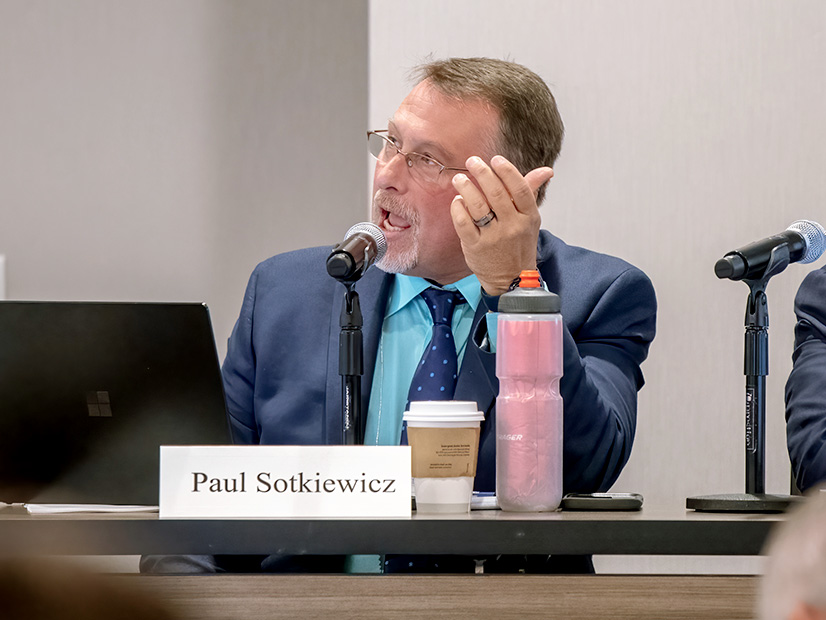Stakeholders reacted sharply to additional detail presented on PJM’s straw proposal to create a one-off expedited application window for high-capacity-factor generation interconnection requests. (See PJM Proposes Expedited Interconnection Studies for High-capacity Factor Generation.)
The proposal would allow a limited number of projects to be added to the initial clusters of Transitional Cycle 2 (TC2) to meet growing resource adequacy concerns staff have identified in the 2029/30 delivery year. The cycle currently includes only projects submitted between October 2020 and September 2021. More details on PJM’s proposal will be presented at the Oct. 30 Markets and Reliability Committee meeting. (See “PJM Models Suggest Capacity Shortfall Possible in 2029/30 Delivery Year,” PJM PC/TEAC Briefs: Aug. 6, 2024.)
These approaches to determining eligibility were presented: allowing only projects with an effective load carrying capability (ELCC) class rating of 45% or higher or a formula with weighted factors such as ELCC rating; whether a project is an uprate or greenfield; expected commercial operation date; MW output and permitting required.
The options would limit the number of projects being expedited to 100, which Director of Interconnection Planning Donnie Bielak said is the approximate number of projects staff believe can be analyzed without significant disruption to the milestones of other projects in the queue. If more than 100 projects are submitted, PJM would prioritize them on the amount of accredited capacity they could deliver.
The 45% ELCC rating approach would categorically prohibit the participation of onshore wind, intermittent hydroelectric, and fixed and tracking solar, as well as projects being built as part of a state agreement approach (SAA) project. The in-service date would need to be June 1, 2029, or earlier.
Speaking during the Organization of PJM States Inc. (OPSI) annual meeting Oct. 21, Ohio Lt. Gov. Jon Husted (R) said state leaders had met with PJM and requested the RTO create an expedited process for interconnecting resources that could be available any time of day.
“Thank you and let’s go, that’s how we feel about it. We appreciate PJM’s responsiveness to our request,” Husted said.
Speaking at OPSI, PJM’s Executive Vice President of Market Services and Strategy Stu Bresler said the initiative is meant to ensure that capacity market price signals can be acted on by generation developers. He said there are investors who want to act on high price signals sent in the 2025/26 Base Residual Auction but can’t do so while PJM progresses through its transitional approach to studying interconnection requests.
PJM CEO Manu Asthana echoed that sentiment, saying load growth is accelerating at the same time generation deactivations are outpacing new entry. The Reliability Resource Initiative (RRI) would allow resources to respond to market signals quickly enough to address reliability concerns.
“I think it’s important to create an onramp for additional resources that want to participate and provide that reliability,” he said.
Several stakeholders at the Oct. 18 PC meeting said the proposal would amount to queue jumping, allowing preferred categories of generation to skip a line of mostly renewable resources that has spanned years.
The projected reliability gap also was called into question, with stakeholders arguing that the markets are functioning to procure sufficient capacity and ancillary services. More data was requested around load forecasting and operational needs PJM expects.
E-Cubed Policy Associates President Paul Sotkiewicz said PJM has not articulated a need to disrupt the rules generation owners have relied on to bring their units to those markets.
“There’s nothing, absolutely nothing that tells me that we have to move quickly at this point,” he said.
PJM Senior Director of Market Design and Economics Becky Caroll said the RTO’s Energy Transition in a series of PJM reports have documented the resource adequacy needs and the reliability services that intermittent resources in the interconnection queue are not expected to provide.
On the other hand, stakeholders said it could create a pathway for adding storage to existing resources or unlock potential for existing generation to make upgrades to increase total capacity.
Bielak said the proposal is one of three avenues PJM is investigating for addressing its reliability concerns, pointing to rule changes on capacity interconnection rights (CIRs) transfers to allow deactivating generation to be more easily replaced with new resources. The Planning Committee endorsed one of three proposals during its Oct. 8 meeting. (See PJM Stakeholders Endorse Coalition Proposal on CIR Transfers.)
PJM also is open to re-evaluating its surplus interconnection service (SIS) rules, which allow new resources to be co-located with existing generation so long as there are no material adverse impacts and the combined output does not exceed the original resource’s CIRs.



